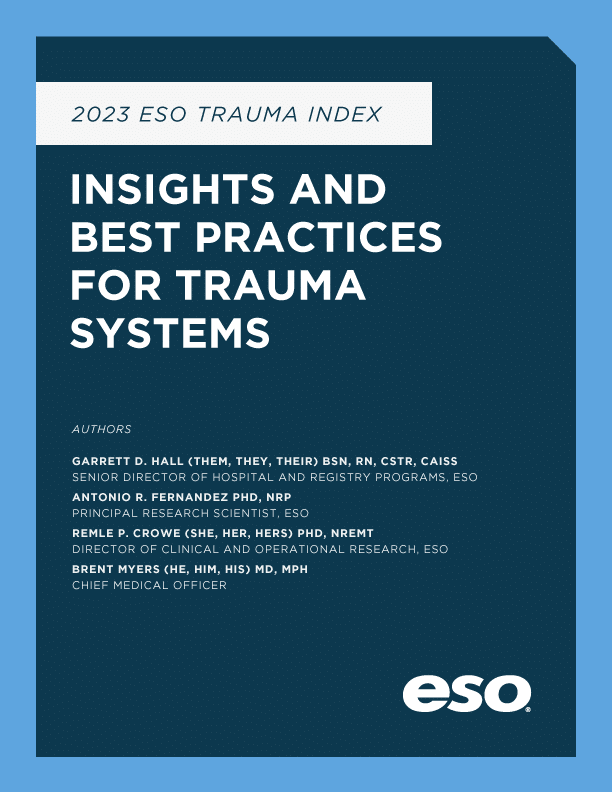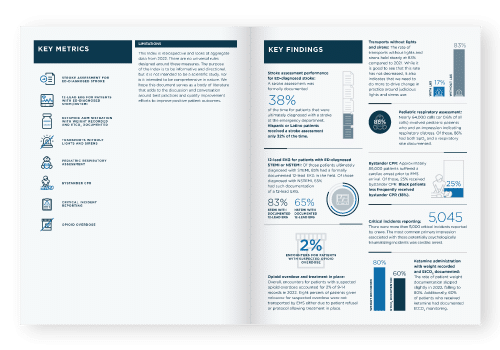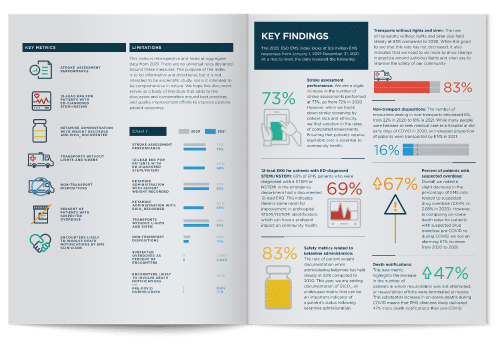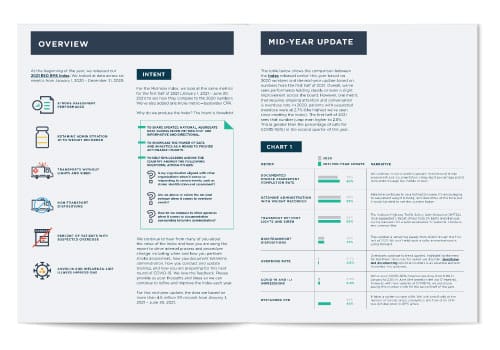The post 2025 ESO EMS Index appeared first on ESO.
]]>The post 2024 ESO EMS Index appeared first on ESO.
]]>Now, in its fifth year, the 2024 ESO EMS Index looks at data from over 12 million incidents nationwide from January 1-December 31, 2023. With the insights gleaned from this Index, the ESO research team hopes to give agencies benchmarks for refining their strategies towards improving patient outcomes in these areas.
The 2024 ESO EMS Index helps answer questions such as:
-
- What best practices can my organization implement to measure and address disparities in analgesic administration?
- Is my organization on par with other organizations in offering full stroke bundles?
- Are we properly monitoring and assessing patients who receive intramuscular sedation?
- Are we on par with the national average when it comes to ambulance patient offload times?
- What is our community’s rate of bystander CPR and could we offer public health outreach?
- Does my organization encourage EMS clinicians to report critical incidents?
- How do we compare to our peers in our opioid overdose response?
- What are the best practices for each metric and how do I ensure my organization follows them?
Want to see how your agency compares? Access the 2024 ESO EMS Index here or have it delivered to your inbox by completing the form.
Discover How ESO Can Transform Your Agency
Curious to see how the insights from the 2024 EMS Index translate into practical solutions for your agency? Schedule a demo and discover how ESO EHR can help your agency achieve success by leveraging technology and data to navigate the evolving demands of the industry.

The post 2024 ESO EMS Index appeared first on ESO.
]]>The post 2023 ESO Trauma Index appeared first on ESO.
]]>The 2023 Trauma Index was designed to be a point of reference for both hospital and trauma centers who want to identify where they align with other organizations throughout the U.S. and where they can improve.
The Trauma Index uses ESO data compiled from nearly 596 participating organizations and represents 968,538 patient records from January 1 through December 31, 2022.
Use it as a guide to help your own data answer questions such as:
- Should we evaluate how we use whole blood versus packed red blood cells for traumatic injuries?
- Are we administering antibiotics early enough to reduce infections and complications when treating open long bone fractures?
- Are we moving geriatric patients with hip fractures to the OR quickly enough or do we need to reevaluate our practices?
- What do different values of systolic blood pressure and shock index indicate in penetrating trauma victims?
- How effectively are we at mitigating and reducing common hospital events (such as unplanned admission to the ICU and delirium) compared to national data?
- When it comes to the Injury Severity Score, how do our mortality rates align with the national average?
Read the 2023 Trauma Index here
Webinar: Data Insights for Trauma Systems
Join us for the ESO Data Café webinar series, where our industry experts will take a close look at each metric in the 2023 ESO Trauma Index and serve up insights that empower you to get the most out of your trauma registry software. Plus, you can earn nursing and registry-specific continuing education contact hours! See full details on the ESO Data Café registration page.
Webinars are scheduled on the third Thursday of every month from 12-1 p.m. CT.
The post 2023 ESO Trauma Index appeared first on ESO.
]]>The post 2023 ESO EMS Index appeared first on ESO.
]]>Based on data from more than 2,500 agencies and departments across the country and representing 11 million EMS responses between January 1, 2022-December 31, 2022, the Index helps EMS leaders answer questions such as:
- Is my organization performing similarly to other organizations around the country when it comes to best practices surrounding certain clinical presentations, such as stroke identification and assessment?
- Are we properly monitoring patients following our use of ketamine in emergent situations?
- Are we practicing judicious use of lights and siren?
- Are we above or below the national average when it comes to responding to overdose events?
- What best practices can my organization implement to help measure and address disparities in prehospital care?
- What are the best practices for each metric in this Index and how can I make sure we are following these at our organization?
Now in its sixth year, this Index not only examines the performance, but makes comparisons to the previous year’s data. ESO’s research team has designed this report to give EMS organizations a benchmark or point of reference for evaluation and improvement. This provides agencies a starting framework to continually refine strategies, increase efficiency, improve outcomes, and allocate resources appropriately.
Read the Index for analysis of stroke assessment performance, ketamine administration, overdose encounter trends, and more. Access the 2023 Index here or, to have it delivered to your inbox, complete the form.
The post 2023 ESO EMS Index appeared first on ESO.
]]>The post 2022 ESO Trauma Index appeared first on ESO.
]]>The 2022 Trauma Index is a point of reference for hospitals and trauma centers to identify which metrics are in alignment with other organizations around the country and which metrics represent an opportunity for improvement–or at least further assessment and evaluation.
The 2022 Trauma Index uses ESO data compiled from nearly 550 participating hospitals and represents 884,456 patient records from January 1, 2021, through December 31, 2021.
Here are some of the questions the 2022 Trauma Index will help you ask and investigate using your own data:
- Should my organization evaluate how we use whole blood versus packed red blood cells for traumatic injuries?
- In the case of open long bone fractures, is my organization administering antibiotics early enough to reduce the risk of infection and complications?
- How quickly is my organization moving geriatric patients with hip fractures from the Emergency Department to the Operating Room? Do we need to evaluate our processes?
- How effectively is my organization mitigating and reducing common hospital events (such as unplanned admission to the ICU and delirium) compared to national data?
- Do my organization’s mortality rates compared to Injury Severity Score align with national data?
Fill out the form on this page to have the 2022 ESO Trauma Index delivered directly to your inbox.
The post 2022 ESO Trauma Index appeared first on ESO.
]]>The post ESO EMS Index 2022 appeared first on ESO.
]]>- Is my organization performing similarly to other organizations around the country when it comes to best practices surrounding certain clinical presentations, such as stroke identification and assessment?
- Are we properly monitoring patients following our use of ketamine in emergent situations?
- Are we practicing judicious use of lights and siren?
- Are we above or below the national average when it comes to responding to overdose events?
- What best practices can my organization implement to help measure and address disparities in prehospital care?
- How can I help my organization support EMS clinicians with the knowledge and skills needed to deliver death notifications?
- How do our responses ending in non-transport compare to the national average?
- What are the best practices for each metric in this Index and how can I make sure we are following these at our organization?
Now in its fifth year, this Index not only examines the performance, but makes comparisons to the previous year’s data. Therefore, the best practices are informed by several years of data, as well as the practical, firsthand experience of seasoned medical professionals.
Read the Index for analysis of stroke assessment performance, ketamine administration, overdose encounter trends, and more. Access the 2022 Index here or, to have it delivered to your inbox, complete the form.
The post ESO EMS Index 2022 appeared first on ESO.
]]>The post 2021 ESO EMS Index: Mid-Year Update appeared first on ESO.
]]>For the Mid-Year Index, we look at the same metrics as first half of 2021 (January 1, 2021 – June 30, 2021) to see how they compare to the 2020 numbers. Those metrics include:
- Stroke Assessment Performance
- Ketamine Administration with Weight Recorded
- Transports Without Lights and Sirens
- Non-Transport Dispositions
- Percent of Patients with Suspected Overdose
- COVID-19 and Influenza-Like Illness Impressions
- NEW – Bystander CPR
These findings are based on data from more than 2,000 agencies and departments across the country and represent 4.6 million 911 calls (out of 10.5 million total calls) between January 1, 2021 – June 30, 2021.
This Index not only examines the performance but also makes comparisons to the previous year’s data. Therefore, the best practices are informed by several years of data as well as the practical, firsthand experience of seasoned medical professionals.
Read the Mid-Year Index for analysis of stroke assessment performance, non-transport dispositions, influenza-like illness, overdose encounter trends, and more. Access the Mid-Year Index here or, to have it delivered to your inbox, complete the form.
The post 2021 ESO EMS Index: Mid-Year Update appeared first on ESO.
]]>The post Duty to Act: Maintaining Compassion and Safety appeared first on ESO.
]]>Watch the discussion to explore questions such as:
- Dealing with increased stress and an overworked staff – how do you manage?
- What are the most appropriate and common uses of chemical restraints and how do you administer and monitor?
- What are EMS’ legal, moral and professional duties to act? How do you do that with both compassion and safety for all – even difficult patients?
Fill out the form to watch this on-demand webinar, instantly.
WEBINAR SPEAKERS
 STEVE WIRTH ESQ, EMT-P
STEVE WIRTH ESQ, EMT-P
Steve Wirth is a founding member of Page, Wolfberg & Wirth and counsels ambulance services and EMS agencies across the country in a wide range of medical transportation, reimbursement, compliance, labor and employment, and corporate law issues. He has over 40 years of experience as an EMT, paramedic, flight paramedic, EMS instructor, fire officer, and EMS administrator.
 WALT A. STOY, PHD, EMT-P
WALT A. STOY, PHD, EMT-P
Walt Stoy is a professor and the founding director of the Emergency Medicine Program in the Department of Rehabilitation Science and Technology at the University of Pittsburgh School of Health and Rehabilitation Sciences.
 SCOTT BOURN, PHD, RN, PARAMEDIC, FACHE
SCOTT BOURN, PHD, RN, PARAMEDIC, FACHE
Scott Bourn PhD, RN, Paramedic, FACHE is an experienced clinician, educator, researcher and clinical practice leader in the EMS, ED, and ICU settings. His research, writing, and lecture topics focus on defining, measuring, and improving patient outcomes and experience.
Dr. Bourn serves as the Vice President of Clinical Quality & Impact at Securisyn Medical, Senior Quality Consultant and Research Chair at ESO, and Co-Director of the NAEMSP Quality & Safety Course.
The post Duty to Act: Maintaining Compassion and Safety appeared first on ESO.
]]>The post Pre-Hospital Ketamine Infographic appeared first on ESO.
]]>The post Pre-Hospital Ketamine Infographic appeared first on ESO.
]]>The post Let’s Talk Real Numbers: Combatting EMS Burnout appeared first on ESO.
]]>How can data drive these efforts? Watch as Dr. Remle Crowe and Dr. Antonio Fernandez discuss the latest research related to burnout and turnover in EMS, along with how agencies can leverage the power of data to monitor factors related to burnout, take action and reduce turnover.
You’ll learn about data-driven strategies including:
- Monitoring assault on providers
- Tracking critical incidents detrimental to mental health
- Recording exposures to dangerous substances or diseases like COVID-19
- Providing follow-up on patient outcomes after transfer of care at the emergency department
OUR SPEAKERS

REMLE CROWE, PhD, NREMT
Dr. Crowe is an expert in using data to power quality improvement and research initiatives in EMS. From truck clutches to clinical care, she has shown how improvement science and sound research methodology work to solve problems across fields. As an EMT with a passion for advancing EMS, she earned her PhD in epidemiology and has authored numerous peer-reviewed publications. Now, as a research scientist at ESO, Dr. Crowe routinely uses data to improve community health and safety.
 ANTONIO R. FERNANDEZ, PhD, NRP, FAHA
ANTONIO R. FERNANDEZ, PhD, NRP, FAHA
Dr. Fernandez is a research scientist at ESO. He has been a nationally certified paramedic for over 15 years. In 2010, Dr. Fernandez completed the NREMT EMS Research Fellowship and earned his doctorate in Epidemiology at The Ohio State University. Before he came to ESO, Dr. Fernandez worked on state repository EMS research as Research Director for the EMS Performance Improvement Center at UNC-Chapel Hill.
The post Let’s Talk Real Numbers: Combatting EMS Burnout appeared first on ESO.
]]>



